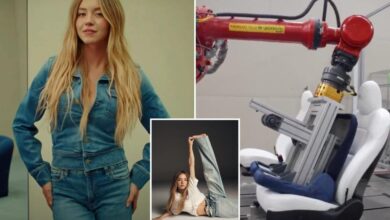I had my fourth baby at 50 — what was better this time around

By the time Frances Largeman-Roth turned 45, she’d all but given up on her desire to become a mom — of four.
She’d experienced two miscarriages in her early 40s, was in perimenopause, and didn’t think she was interested in IVF. Plus, she was grateful for her three healthy, happy kids, a fulfilling career as a dietitian and writer, and a home and husband she loved.
“I was trying to go with that concept of: If it’s not meant to be, it’s not meant to be,” Largeman-Roth, who lives in Westchester County told The Post.
But as she was approaching 50 in 2022, Largeman-Roth read a New Yorker essay about a couple who conceived in their late 40s using a donor egg. She couldn’t get it out of her head.
“Once that seed is planted of imagining a child, it’s very difficult to completely cast those thoughts aside,” Largeman-Roth said. “You can park them somewhere for a while, but they never truly go away.”
So she and her husband visited a fertility specialist, who assessed that Largeman-Roth was a “perfect” candidate for pregnancy via donor egg. She was fit and healthy, free of disease and not on medications, and her prior pregnancies had been smooth.
Importantly, Largeman-Roth added, “the real reason I wanted another baby is because I still had so much love to give, and felt healthy and energetic enough to make that commitment.”
Egg donation 101
Put simply, egg donation involves using a younger woman’s eggs, fertilizing them with sperm (in this case, Largeman-Roth’s husband’s) in a lab and using assisted reproductive technology to implant a resulting embryo into the mom-to-be’s uterus.
While egg quality and quantity declines with age — most precipitously after 35 — due to hormonal changes, the uterus is “really just an organ that’s responsive to hormonal cues,” explained Dr. Tia Jackson-Bey, a reproductive endocrinologist and infertility specialist at RMA New York.
“Women who use donor eggs after they’ve undergone menopause can still technically carry a baby, although it’s not without risk.”
Dr. Tia Jackson-Bey
So if the uterus is receiving hormones, like during a woman’s reproductive years or via injections, it “does what it’s told,” Jackson-Bey said, whether that’s to support a pregnancy or to prompt a period. And if it’s not receiving hormones, like after menopause, the uterus “just sits there and impatiently waits.”
“That’s why,” Jackson-Bey said, “women who use donor eggs after they’ve undergone menopause or are in their perimenopausal transition can still technically carry a baby, although it’s not without risk.”
For example, older women are at higher risk for gestational diabetes, postpartum hemorrhage, and the life-threatening pregnancy complication pre-eclampsia. They are also more likely to get the sorts of medical conditions that are prevalent in midlife and beyond — hypertension, diabetes, cancer — which can complicate, and endanger, a pregnancy.
There are increased risks for a baby-to-be of an older mom, too, like intrauterine growth restriction, when the fetus doesn’t grow at an expected rate.
Placental issues like placenta previa (when the placenta blocks the cervix, often leading to a C-section) are also more common in older moms.
Then, there are social and psychological considerations: Are you comfortable not being biologically related to your child? “That can be a big stumbling block that prevents people from moving forward,” Jackson-Bey said.
Are you emotionally and financially stable? Using donor eggs still doesn’t guarantee a baby, and the process — which isn’t typically covered by insurance — can cost couples $15,000 to $50,000, Jackson-Bey estimates.
“I had no problems with anything until after the baby was born.”
Frances Largeman-Roth
Largeman-Roth braced for judgment, too. “I was expecting to have a lot more negative comments and questions, like, ‘Why would you do this?’ and ‘Don’t you know you might not be around to see this kid reach 30?’ ” she said. “I was really dreading that.”
But the upsides can be profound, Jackson-Bey said. Her patients who’d been unsure about egg donation but ultimately pursued it are “the most grateful,” she’s found.
“There’s so much gratitude, like, ‘Wow, we almost didn’t have this opportunity and now we do, and we’re just so happy for it,’ ” she said.
Getting pregnant later in life
Braced with the risks and realities, Largeman-Roth used a donor bank to “shop” before settling on a healthy “anonymous” donor in her early 20s who shared some of her physical features. She didn’t want to share how much she paid for eggs, which her insurance wouldn’t cover, though it would cover up to three rounds of the IVF part of the process.
“I don’t want people to think I just did this on a whim. This was something you have to think long and hard about,” she said.
The bank sold eggs in sets of six to account for the fact that not all will survive fertilization — and those that do might not implant in the uterus. Indeed, Largeman-Roth’s six chosen eggs yielded three embryos with her husband’s sperm.
The first transfer didn’t take. The second one — aided with acupuncture and other stress-reduction techniques — did.
“They gave me the good news, and I completely burst out crying I was so thrilled,” Largeman-Roth, who was 50 at the time, remembers. The lead-up had been more than emotionally taxing: IVF requires people to take medications and hormone shots to prep the uterus for implantation.
“The shots are brutal,” Largeman-Roth admitted. “Going up and down the stairs was miserable. You have bruises all over your hips.”
Pregnant at 50: Self-pampering and calf cramps
But throughout the pregnancy, Largeman-Roth said she felt “pretty darn great.” She was on her Peloton or doing a strength-training workout six days a week.
Unlike her first three pregnancies in her 30s, when she was working and riding the subway in New York City, this time around she worked from home and had no toddlers to wrangle. “I could definitely baby myself a lot more,” she said.
“It just goes to show that, like in any pregnancy, there’s risk.”
Frances Largeman-Roth
She did, though, suffer from “horrible, horrible” calf cramps. “My calf would seize up and then for about three or four days afterward it was incredibly sore,” she said.
Her doctors’ appointments were more frequent too. She saw her OB-GYN on a regular schedule, plus a high-risk doctor monthly to check for signs of complications and to ensure the fetus was growing properly.
She also underwent a fetal echocardiogram at around six months to detect heart defects. She took baby aspirin to lower the risk of blood clots, and eventually took her blood pressure daily at home.
“I had no problems with anything,” Largeman-Roth said, “until after the baby was born.”
Delivery, a NICU stay — and motherhood
Delivered via C-section since the baby was in breech, the little girl, Romy, had to undergo surgery for a hole in her diaphragm that had been spotted late in the pregnancy.
“Of course I said to myself, ‘This is why you used a donor, so that it would be 100% perfect and no issues.’ But it was just one of those things you can’t control,” she said.
“It just goes to show that, like in any pregnancy, there’s risk. This wasn’t because I was 50. And it wasn’t because I used a donor egg. It just happened.”
When Largeman-Roth finally met Romy in the NICU — about eight hours post-birth to account for the newborn’s surgery and Largeman-Roth’s C-section — “I kind of felt like: It’s going to be OK.”
Still, she wasn’t out of the woods: Three days after the birth, Largeman-Roth developed pre-eclampsia and was put on a magnesium drip.
But now, over six months later, she and her baby are both healthy. Romy is smiley and babbly, and Largeman-Roth is relishing recent inventions like the Snoo and lighter, more portable car seats and strollers.
Her older kids — now 11, 13 and 16 — help out (though they draw the line at diaper changes). And the questioning from other moms is minimal, and largely supportive.
These days, “I have the knowledge and the wisdom to know that this baby stage is so fleeting,” she said. “I’m really just trying to soak it all in.”
Credit to Nypost AND Peoples




